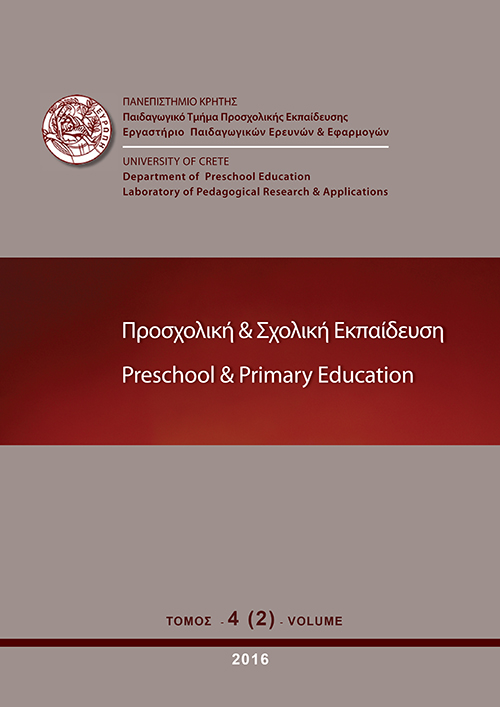Φιλικές σχέσεις μαθητών με και χωρίς Διαταραχή Ελλειμματικής Προσοχής-Υπερκινητικότητα (ΔΕΠ-Υ) στο δημοτικό σχολείο
Abstract
Η φιλία είναι μια δυαδική, εθελοντική, αμοιβαία σχέση, η οποία προϋποθέτει την παρουσία ενός αμοιβαίου συναισθηματικού δεσμού ανάμεσα στα μέλη της. Φιλικές σχέσεις με θετικά και αρνητικά ποιοτικά χαρακτηριστικά μπορούν να δημιουργηθούν μεταξύ παιδιών με και χωρίς Διαταραχή Ελλειμματικής Προσοχής – Υπερκινητικότητα (ΔΕΠ-Υ). Τα παιδιά με ΔΕΠ-Υ, πάντως, αντιμετωπίζουν σημαντικές δυσκολίες στη δημιουργία και διατήρηση φιλικών σχέσεων (Blachman & Hinshaw, 2002). Σκοπός της παρούσας έρευνας είναι να εξετάσει τις αντιλήψεις για την ποιότητα της φιλίας μαθητών με ή χωρίς ΔΕΠ-Υ που φοιτούν στο δημοτικό σχολείο, τη διάρκεια των φιλικών σχέσεων τους και τις προτιμήσεις τους αναφορικά με την επιλογή των φίλων τους. Οι συμμετέχοντες στην έρευνα ήταν 102 παιδιά με τυπική ανάπτυξη και 22 παιδιά με διάγνωση ΔΕΠ-Υ από κρατικό φορέα, μέσης ηλικίας 9,51 ετών (τ.α.=1,30, ηλικιακό εύρος: 8 έως 12 έτη).Τα εργαλεία που χρησιμοποιήθηκαν για τη συλλογή δεδομένων ήταν ένα κοινωνιόγραμμα και μια κλίμακα αξιολόγησης της ποιότητας φιλίας, καθώς και ένα ερωτηματολόγιο με δημογραφικά στοιχεία και πληροφορίες για τα χαρακτηριστικά των φιλικών σχέσεων των παιδιών. Τα αποτελέσματα έδειξαν ότι τα παιδιά με ΔΕΠ-Υ έχουν λιγότερους φίλους στην τάξη τους και οι φιλικές σχέσεις τους είναι βραχύχρονες. Όλα τα παιδιά επιλέγουν ως φίλους συνομηλίκους τους χωρίς κάποια μαθησιακή δυσκολία. Τέλος, οι μαθητές, με και χωρίς ΔΕΠ-Υ περιγράφουν και αντιλαμβάνονται τις φιλικές σχέσεις τους ως ποιοτικές, αποδίδοντάς τους θετικά χαρακτηριστικά. Το κύριο συμπέρασμα της έρευνας είναι ότι ο ρόλος του σχολείου στην ανάπτυξη και ενδυνάμωση των φιλικών σχέσεων χρήζει συστηματικής διερεύνησης, ιδιαίτερα στην ελληνική πραγματικότητα.
Article Details
- Zitationsvorschlag
-
Kouvava, S., Antonopoulou, E., & Maridaki-Kassotaki, E. (2016). Φιλικές σχέσεις μαθητών με και χωρίς Διαταραχή Ελλειμματικής Προσοχής-Υπερκινητικότητα (ΔΕΠ-Υ) στο δημοτικό σχολείο. Preschool and Primary Education, 4(2), 276–290. https://doi.org/10.12681/ppej.8577
- Ausgabe
- Bd. 4 Nr. 2 (2016)
- Rubrik
- Άρθρα

Dieses Werk steht unter der Lizenz Creative Commons Namensnennung - Nicht-kommerziell - Weitergabe unter gleichen Bedingungen 4.0 International.
Οι συγγραφείς των άρθρων που δημοσιεύονται στο ΠΡΟΣΧΟΛΙΚΗ & ΣΧΟΛΙΚΗ ΕΚΠΑΙΔΕΥΣΗ διατηρούν τα δικαιώματα πνευματικής ιδιοκτησίας επί των άρθρων τους, δίνοντας στο περιοδικό το δικαίωμα της πρώτης δημοσίευσης. Άρθρα που δημοσιεύονται στο ΠΡΟΣΧΟΛΙΚΗ & ΣΧΟΛΙΚΗ ΕΚΠΑΙΔΕΥΣΗ διατίθενται με άδεια Creative Commons 3.0 και σύμφωνα με την άδεια μπορούν να χρησιμοποιούνται ελεύθερα, με αναφορά στο/στη συγγραφέα και στην πρώτη δημοσίευση για μη κερδοσκοπικούς σκοπούς και με δικαίωμα τροποποίησης μόνον με παρόμοια διανομή (αν αναμείξετε, τροποποιήσετε, ή δημιουργήσετε πάνω στο υλικό, πρέπει να διανείμετε τις δικές σας συνεισφορές υπό την ίδια άδεια όπως και το πρωτότυπο). To Εργαστήριο Παιδαγωγικών Ερευνών και Εφαρμογών του Παιδαγωγικού Τμήματος Προσχολικής Εκπαίδευσης του Πανεπιστημίου Κρήτης και το Εθνικό Κέντρο Τεκμηρίωσης διατηρούν το δικαίωμα να δημοσιεύουν, να αναπαραγάγουν, να παρουσιάζουν στο κοινό, να διανέμουν και χρησιμοποιούν άρθρα που δημοσιεύονται στο ΠΡΟΣΧΟΛΙΚΗ & ΣΧΟΛΙΚΗ ΕΚΠΑΙΔΕΥΣΗ σε οποιοδήποτε μέσο και μορφή είτε μεμονωμένα είτε ως μέρη συλλογικών έργων, για όλο το χρόνο διάρκειας προστασίας της πνευματικής ιδιοκτησίας και για όλες τις χώρες του κόσμου. Αυτό περιλαμβάνει ενδεικτικά και όχι αποκλειστικά, το δικαίωμα δημοσίευσης των άρθρων σε τεύχη του περιοδικού ΠΡΟΣΧΟΛΙΚΗ & ΣΧΟΛΙΚΗ ΕΚΠΑΙΔΕΥΣΗ, αναπαραγωγής και διανομής μεμονωμένων αντιγράφων των άρθρων, αναπαραγωγής ολόκληρων των άρθρων σε άλλη έκδοση του Εργαστηρίου Παιδαγωγικών Ερευνών και Εφαρμογών του Παιδαγωγικού Τμήματος Προσχολικής Εκπαίδευσης του Πανεπιστημίου Κρήτης και του Εθνικού Κέντρου Τεκμηρίωσης και αναπαραγωγής και διανομής των άρθρων ή περίληψης αυτών με χρήση πληροφορικού συστήματος αποθετηρίου.



